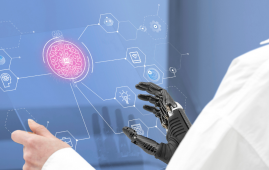

The “scarred villain” is one of the oldest tropes in film and literature, from Scar in “The Lion King” to Star Wars’ Darth Vader and the Joker in “The Dark Knight.” The trope is likely rooted in a long-evolved human bias against facial anomalies—atypical features such as growths, swelling, facial paralysis, and scars. A new brain-and-behavior study from researchers in the Perelman School of Medicine at the University of Pennsylvania illuminates this bias on multiple levels.
The researchers, whose findings were published this week in the Annals of the New York Academy of Sciences, used surveys, social simulations, and functional MRI (fMRI) studies to study hundreds of participants’ responses and attitudes towards attractive, average, and anomalous faces. The findings clarify how the ‘anomalous-is-bad’ stereotype manifests, and implicate a brain region called the amygdala as one of the likely mediators of this stereotype.
“Understanding the psychology of the ‘anomalous-is-bad’ stereotype can help, for example, in the design of interventions to educate the public about the social burdens shouldered by people who look different,” said lead author Clifford Workman, Ph.D., a postdoctoral researcher in the Penn Center for Neuroaesthetics. The center is led by Anjan Chatterjee, MD, a professor of Neurology at Penn Medicine, who was the senior author of the study.
Bias against people with facial disfigurements has been demonstrated in various prior studies. Researchers broadly assume that this bias reflects ancient adaptive traits that evolved to promote healthy mate selection, for example, and to steer us clear of people who have potentially communicable diseases. Regardless of the cause, for many people, their facial anomalies render them unjust targets of discrimination.
In their study, Workman and colleagues investigated how this bias manifests at different levels, from expressed attitudes towards faces to actual behavior during simulated social interactions, and even down to brain responses when viewing faces.
In one part of the study, the researchers showed a set of faces that were either average-looking, attractive, or anomalous to 403 participants from an online panel, and asked them to rate the depicted people on various measures. The researchers found that, compared to more attractive faces, participants considered anomalous faces less trustworthy, less content, and more anxious, on average. The anomalous faces also made the participants feel less happy. Participants also acknowledged harboring “explicit bias” reflected in negative expectations about people with anomalous faces as a group.
In the other part of the study, Workman and colleagues examined moral attitudes and dispositions, the behavior during simulated social interaction, and fMRI-measured brain responses, for 27 participants who viewed similar sets of faces.
Here again, there was some evidence of the anomalous-is-bad habit of thinking, though it was not clear that this translated into mistreatment of people with anomalous faces. For example, in a simulated donation game measuring pro-sociality—the willingness to be positive and helpful towards another—the participants were not significantly less pro-social towards anomalous-looking people. However, participants in the highest tier of socioeconomic status, compared to the others, were significantly less pro-social towards anomalous-looking people.
On fMRI scans, brain regions called the amygdala and the fusiform gyri showed significant neural responses specifically to anomalous faces. Activity in a portion of the left amygdala, which correlated with less pro-sociality towards anomalous faces, also seemed related to participants’ beliefs about justice in the world and their degree of empathic concern.
“We hypothesize that the left amygdala integrates face perception with moral emotions and social values to guide behavior, such that weaker emotional empathy, and a stronger belief that the world is just, both facilitate dehumanizing people with facial anomalies,” Chatterjee said.
Analyzing such responses is inherently challenging because they involve a mix of subjective perceptions, such as the ‘visual salience,’ or relative importance, of a face, and the ’emotional arousal’ elicited by seeing the face. To inform future research, as part of the study, the team used the fMRI data to clarify which brain regions are associated with these distinct aspects of the experience of seeing faces.
more recommended stories
 Safer Allogeneic Stem Cell Transplants with Treg Therapy
Safer Allogeneic Stem Cell Transplants with Treg TherapyA new preclinical study from the.
 Autoimmune Disorders: ADA2 as a Therapeutic Target
Autoimmune Disorders: ADA2 as a Therapeutic TargetAdenosine deaminase 2 (ADA2) has emerged.
 Kaempferol: A Breakthrough in Allergy Management
Kaempferol: A Breakthrough in Allergy ManagementKaempferol, a dietary flavonoid found in.
 Early Milk Cereal Drinks May Spur Infant Weight Gain
Early Milk Cereal Drinks May Spur Infant Weight GainNew research published in Acta Paediatrica.
 TaVNS: A Breakthrough for Chronic Insomnia Treatment
TaVNS: A Breakthrough for Chronic Insomnia TreatmentA recent study conducted by the.
 First-of-Its-Kind Gene-Edited Pig Kidney: Towana’s New Life
First-of-Its-Kind Gene-Edited Pig Kidney: Towana’s New LifeSurgeons at NYU Langone Health have.
 Just-in-Time Training Improves Success & Patient Safety
Just-in-Time Training Improves Success & Patient SafetyA study published in The BMJ.
 ChatGPT Excels in Medical Summaries, Lacks Field-Specific Relevance
ChatGPT Excels in Medical Summaries, Lacks Field-Specific RelevanceIn a recent study published in.
 Study finds automated decision minimizes high-risk medicine combinations in ICU patients
Study finds automated decision minimizes high-risk medicine combinations in ICU patientsA multicenter study coordinated by Amsterdam.
 Study Discovers Connection Between Omicron Infection and Brain Structure Changes in Men
Study Discovers Connection Between Omicron Infection and Brain Structure Changes in MenA recent study in the JAMA.

Leave a Comment